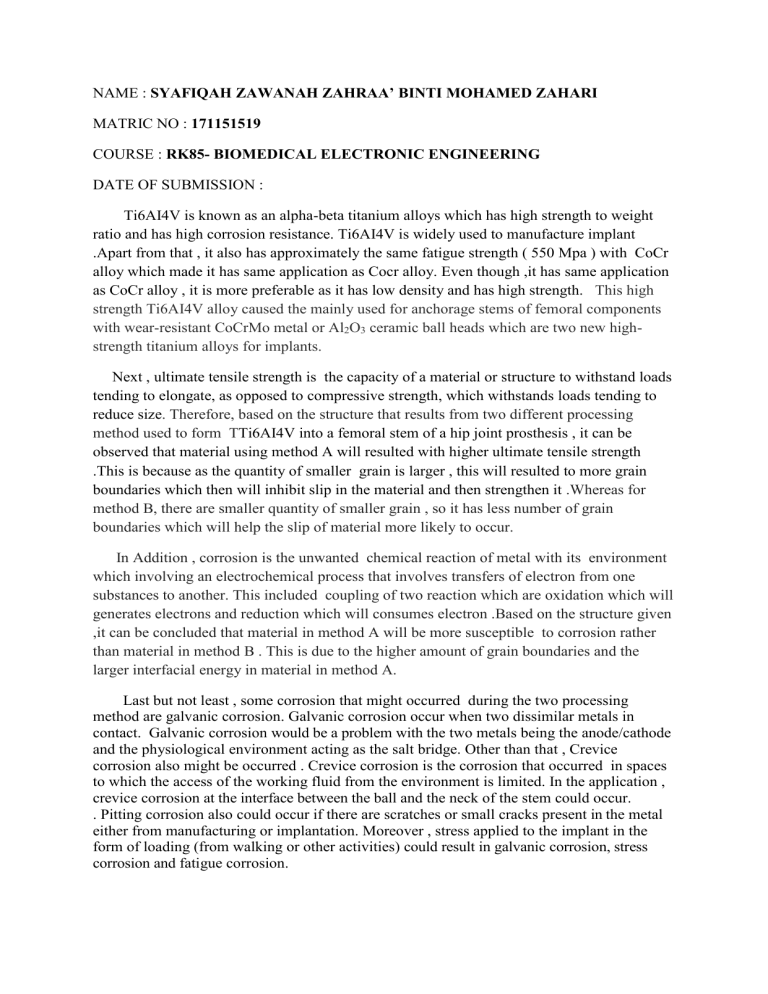
NAME : SYAFIQAH ZAWANAH ZAHRAA’ BINTI MOHAMED ZAHARI MATRIC NO : 171151519 COURSE : RK85- BIOMEDICAL ELECTRONIC ENGINEERING DATE OF SUBMISSION : Ti6AI4V is known as an alpha-beta titanium alloys which has high strength to weight ratio and has high corrosion resistance. Ti6AI4V is widely used to manufacture implant .Apart from that , it also has approximately the same fatigue strength ( 550 Mpa ) with CoCr alloy which made it has same application as Cocr alloy. Even though ,it has same application as CoCr alloy , it is more preferable as it has low density and has high strength. This high strength Ti6AI4V alloy caused the mainly used for anchorage stems of femoral components with wear-resistant CoCrMo metal or Al2O3 ceramic ball heads which are two new highstrength titanium alloys for implants. Next , ultimate tensile strength is the capacity of a material or structure to withstand loads tending to elongate, as opposed to compressive strength, which withstands loads tending to reduce size. Therefore, based on the structure that results from two different processing method used to form TTi6AI4V into a femoral stem of a hip joint prosthesis , it can be observed that material using method A will resulted with higher ultimate tensile strength .This is because as the quantity of smaller grain is larger , this will resulted to more grain boundaries which then will inhibit slip in the material and then strengthen it .Whereas for method B, there are smaller quantity of smaller grain , so it has less number of grain boundaries which will help the slip of material more likely to occur. In Addition , corrosion is the unwanted chemical reaction of metal with its environment which involving an electrochemical process that involves transfers of electron from one substances to another. This included coupling of two reaction which are oxidation which will generates electrons and reduction which will consumes electron .Based on the structure given ,it can be concluded that material in method A will be more susceptible to corrosion rather than material in method B . This is due to the higher amount of grain boundaries and the larger interfacial energy in material in method A. Last but not least , some corrosion that might occurred during the two processing method are galvanic corrosion. Galvanic corrosion occur when two dissimilar metals in contact. Galvanic corrosion would be a problem with the two metals being the anode/cathode and the physiological environment acting as the salt bridge. Other than that , Crevice corrosion also might be occurred . Crevice corrosion is the corrosion that occurred in spaces to which the access of the working fluid from the environment is limited. In the application , crevice corrosion at the interface between the ball and the neck of the stem could occur. . Pitting corrosion also could occur if there are scratches or small cracks present in the metal either from manufacturing or implantation. Moreover , stress applied to the implant in the form of loading (from walking or other activities) could result in galvanic corrosion, stress corrosion and fatigue corrosion. REFERENCE . Titanium alloys for hip joint replacements. (2004, August 04). Retrieved from https://www.sciencedirect.com/science/article/pii/0267660587900151 Otani, T., Whiteside, L. A., White, S. E., & McCarthy, D. S. (1993, February). Effects of femoral component material properties on cementless fixation in total hip arthroplasty. A comparison study between carbon composite, titanium alloy, and stainless steel. Retrieved from https://www.ncbi.nlm.nih.gov/pubmed/8436992 Ti-6Al-4V. (2019, January 11). Retrieved from https://en.wikipedia.org/wiki/Ti-6Al-4V Ti6AL4V (grade 5) Titanium alloys processed with rapid casting and CNC. (n.d.). Retrieved from https://www.crpmeccanica.com/machining-titanium-ti6al4v/


